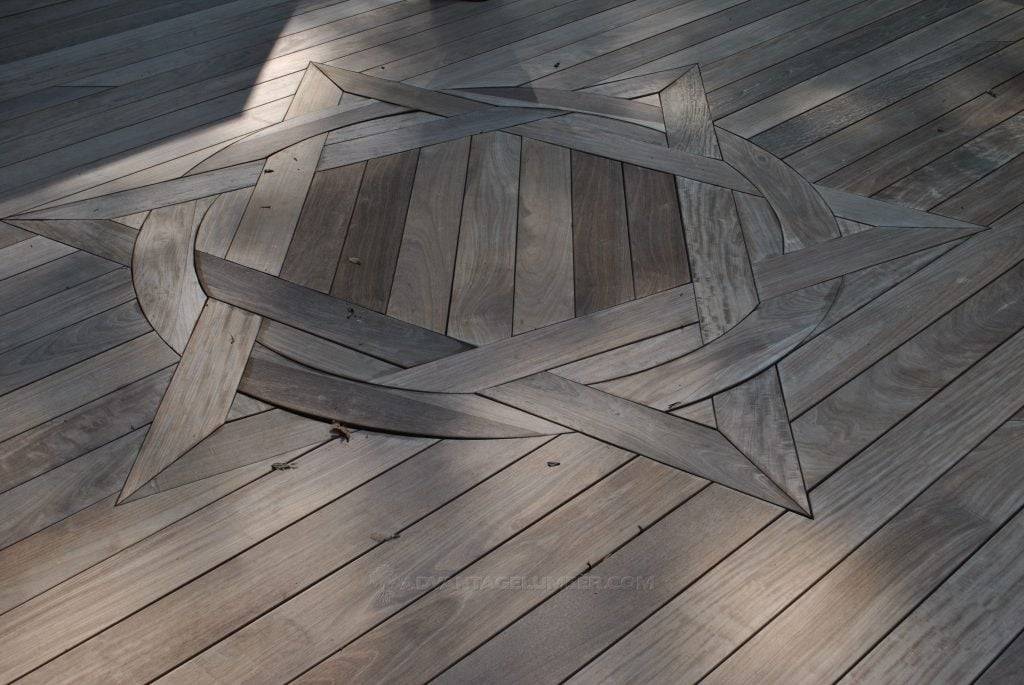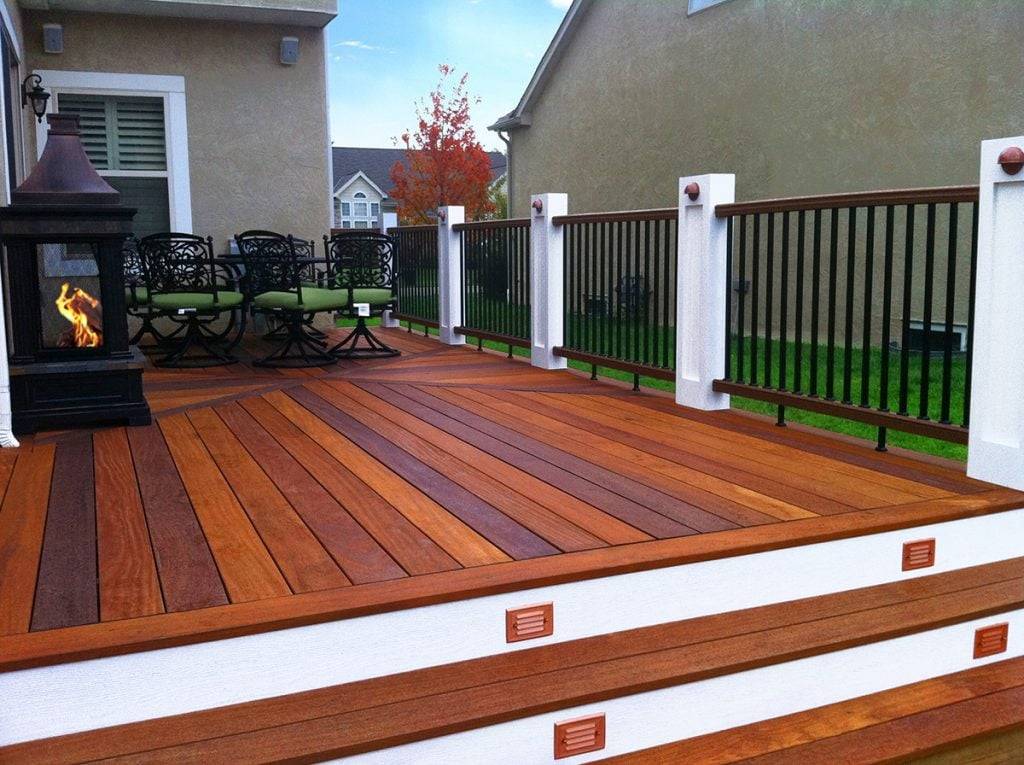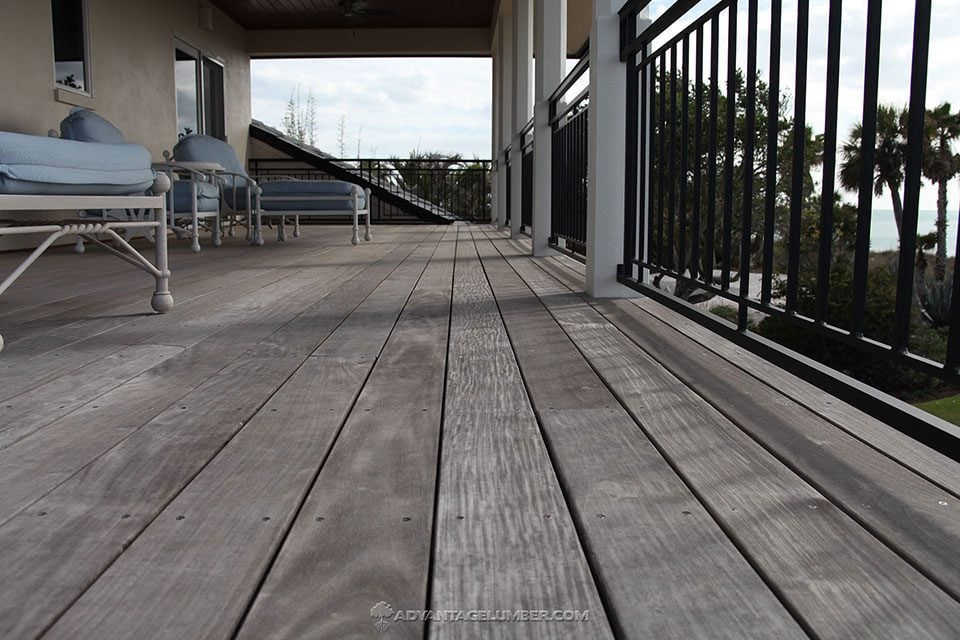Are you a homeowner looking to upgrade your outdoor space with a sleek, low-maintenance decking option? Grey decking is not only stylish but also practical, blending seamlessly with various exterior designs while requiring minimal upkeep. In this blog post, we’ll explore the top four grey decking options, with a focus on durability, aesthetics, and value.
1. Ipe Decking: The Ultimate Low-Maintenance Grey Decking

Ipe decking takes the crown for the best grey decking option for homeowners seeking both beauty and durability. Renowned for its incredible density and hardness, Ipe wood is a top choice for outdoor decking. What sets Ipe apart is its natural ability to weather gracefully into a stunning silver-grey color, offering the sought-after aesthetic without the need for constant maintenance.
Ipe’s dense structure ensures that it retains its structural integrity over time, resisting splintering and large cracks that are common in softer woods like pressure-treated pine. This resilience makes Ipe decking a wise investment for homeowners looking for a long-lasting, low-maintenance solution.
Pros of Ipe Wood Decking
- Durability: Extremely dense and hard, making it very durable and resistant to wear.
- Longevity: Proven to last up to 75 years or more on commercial applications.
- Natural Beauty: Ages to a beautiful silver-grey color, offering a premium aesthetic without the need for stains or paints.
- Low Maintenance: Requires minimal upkeep compared to softer woods; does not need frequent staining or sealing.
- Resistance: Naturally resistant to rot, decay, and insect infestation due to its dense composition.
- Structural Integrity: Retains its structure over time, resisting splintering and cracking.
- Temperature: Wood is a natural insulator so Ipe wood does not get as hot on your bare feet as the composite and PVC decking which many report are dangerously hot on bare feet
Cons of Ipe Wood Decking
- Cost: One of the more expensive wood decking materials on the market. But in 2024 it still only costs $6.00 – $7.00 per lineal foot.
- Weight: Its density makes it heavy, which can complicate the handling and installation process.
- Hardness: The wood’s hardness can make it difficult to cut and install, requiring carbide tip blades however most blades are carbide tipped nowadays but on a large project expect to go through a few blades.
2. Cumaru Decking: The Affordable Alternative to Ipe

Cumaru decking earns the second spot on our list, closely mirroring Ipe’s qualities but at a more accessible price point. Like Ipe, Cumaru boasts impressive density and durability, making it resistant to wear and tear. It also naturally weathers to a beautiful grey hue, providing the same elegant look as Ipe without the premium price tag.
Choosing Cumaru decking means you don’t have to compromise on quality or aesthetics for affordability. It’s an excellent option for homeowners who want the look and feel of Ipe without stretching their budget.
Being that Cumaru is so similar to Ipe the pros and cons are very similar as well.
Pros of Cumaru Decking
- Durability: Extremely dense and hard, making it very durable and resistant to wear.
- Longevity: Proven to last up to 50 years or more on commercial applications.
- Natural Beauty: Ages to a beautiful silver-grey color, offering a premium aesthetic without the need for stains or paints.
- Low Maintenance: Requires minimal upkeep compared to softer woods; does not need frequent staining or sealing.
- Resistance: Naturally resistant to rot, decay, and insect infestation due to its dense composition.
- Structural Integrity: Retains its structure over time, resisting splintering and cracking.
- Temperature: Wood is a natural insulator so Ipe wood does not get as hot on your bare feet as the composite and PVC decking which many report are dangerously hot on bare feet
- Cost: Cumaru can be up to 50% cheaper than Ipe, in 2024 it only costs $3.00 – $4.50 per lineal foot.
Cons of Cumaru Decking
- Weight: Its density makes it heavy, which can complicate the handling and installation process.
- Hardness: The wood’s hardness can make it difficult to cut and install, requiring carbide tip blades however most blades are carbide tipped nowadays but on a large project expect to go through a few blades.
3. TimberTech Decking

Coming in at third place is TimberTech decking, a composite option that combines the beauty of natural wood with the convenience of low maintenance. TimberTech offers a range of grey shades to suit any design preference, from light, airy tones to deep, rich charcoals.
What sets TimberTech apart is its composite construction, which resists fading, staining, and scratching, ensuring your deck looks great for years to come with minimal upkeep. It’s an ideal choice for homeowners who want the aesthetic of natural wood without the hassle of regular maintenance.
Pros of TimberTech Decking
- Low Maintenance: Requires minimal upkeep; no need for sanding, staining, or sealing.
- Durability: Resistant to fading, staining, and scratching, ensuring a long-lasting appearance.
- Variety: Offers a wide range of colors and styles to suit different design preferences.
- Moisture Resistance: Available in Composite and PVC construction which provide excellent resistance to moisture, reducing the risk of rot and decay.
- Sustainability: Many TimberTech products are made from recycled materials, making them an eco-friendly choice.
- Warranty: Offers a 25-50 year warranty depending on the product line, providing peace of mind to homeowners.
Cons of TimberTech Decking
- Cost: Can be more expensive upfront than hardwood decking options.
- Heat Retention: Can get very hot under direct sunlight, which might be uncomfortable for bare feet. The lighter colors are cooler than the dark colors but can still be considered too hot for bare feet.
- Expansion and Contraction: Like other composite materials, it can expand and contract with temperature changes, which may require special installation considerations.
- Strength: Not as strong as hardwood decking and often requires closer joist spacing like 12″ on center and often closer when building deck stairs.
- Natural Look: While it mimics the look of wood, some homeowners may prefer the authentic feel of natural wood.
4. Trex Decking

Rounding out our top four is Trex decking, another composite option known for its sustainability and durability. Trex decking is made from recycled materials, making it an eco-friendly choice for environmentally conscious homeowners.
Like TimberTech, Trex offers a variety of grey shades and requires minimal maintenance to keep its appearance. It’s resistant to fading, staining, and mold, making it a practical and attractive option for any outdoor space.
Pros of Trex Decking
- Low Maintenance: Requires minimal upkeep, with no need for sanding, staining, or sealing.
- Durability: Resistant to fading, staining, scratching, and mold, ensuring a long-lasting appearance.
- Eco-Friendly: Made from up to 95% recycled materials, including plastic and wood scraps.
- Variety: Offers a wide range of colors and styles to suit different design preferences.
- Warranty: Offers a 25 – 50 year limited residential warranty, providing peace of mind to homeowners.
- Moisture Resistance: Composite construction provides excellent resistance to moisture, reducing the risk of rot and decay.
Cons of Trex Decking
- Cost: Can be more expensive upfront than hardwood decking options.
- Heat Retention: Can get very hot under direct sunlight, which might be uncomfortable for bare feet. The lighter colors are cooler than the dark colors but can still be considered too hot for bare feet.
- Expansion and Contraction: Like other composite materials, it can expand and contract with temperature changes, which may require special installation considerations.
- Strength: Not as strong as hardwood decking and often requires closer joist spacing like 12″ on center and often closer when building deck stairs.
- Natural Look: While it mimics the look of wood, some homeowners may prefer the authentic feel of natural wood.
Conclusion
When it comes to choosing the best grey decking for your home, there are several excellent options to consider. Ipe decking stands out as the ultimate low-maintenance choice, with its natural beauty and durability. Cumaru offers a similar aesthetic at a more affordable price, while TimberTech and Trex provide modern composite solutions that are both stylish and practical.
No matter which option you choose, upgrading to grey decking can enhance the look and functionality of your outdoor space, providing a beautiful and low-maintenance area for relaxation and entertainment.
